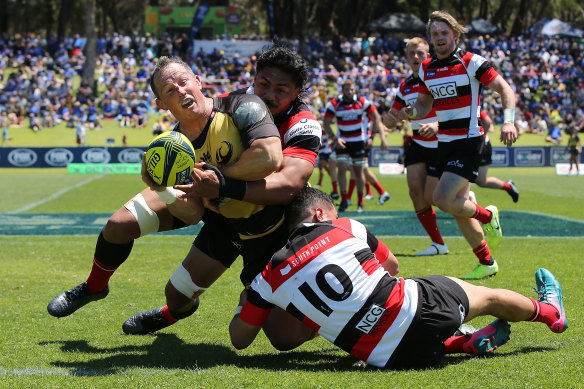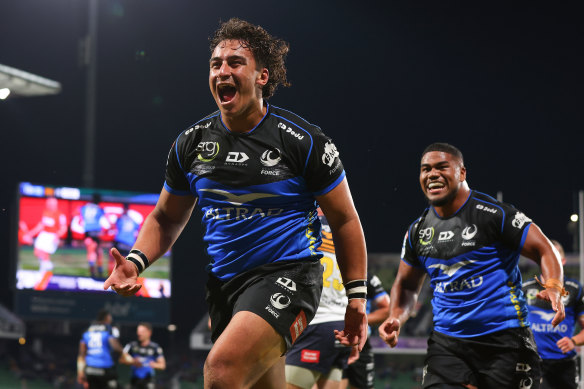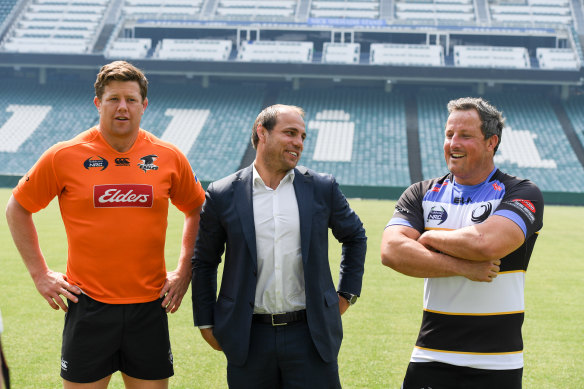- Tight Five
- Sport
- Rugby Union
- Australian rugby
Why new national comp is a ‘need, not a want’ for Australian rugby
By Paul Cully
1. Trans-Tasman wisdom
Tony Lewis used to run Tasman, the small-but-big New Zealand province that is contributing more players to the All Blacks’ Rugby World Cup squad than any other union.
Therefore, the now-Western Force boss was always likely to have a firm view of the benefits of a ‘third tier’ competition for Australia.
But he has told this masthead he is utterly convinced of these things: Australia has comparable young talent to New Zealand; Australian players are currently severely underused compared to New Zealand; the ‘price tag’ of a third-tier competition is manageable, and certainly less than the ‘cost’ of doing nothing; a third tier competition can build the network of coaches, analysts and support staff needed to rebuild Australian rugby; and that Super Rugby clubs are already spending money on overseas tours to fill the months-long gap between Super Rugby seasons.
2. The necessity
“All the Super coaches [in Australia] who participated in that third-tier comp [the NRC] that was running before COVID ... all waxed lyrical about how good a competition it was and the number of coaches that come through it, and the number of S+C coaches [strength and conditioning], the number of analysts, the number of players,” said Lewis in an interview before the Bledisloe series.

The National Rugby Championship had either eight or nine teams between 2014 and 2019 before it was cruelled by the pandemic.Credit: Getty
“So it’s just not about players, it’s about coaches, about analysts, about physios. If you’re not preparing them for the next level, the jump is horrendous. The first time you do economics, they do needs and wants.
“This is not a want, it’s a need ... we’ve all probably got to bite the bullet and see what it looks like.”
3. The elephant in the room.
There’s no such thing as a free lunch in professional sport. While teams like the Force already have players contracted and effectively sitting idle for months, Lewis acknowledged the players’ collective bargaining agreement with Rugby Australia would have to be renegotiated if they were taking part in a new competition.

Lewis’ Force side are preparing for a home-and-away series against the Cheetahs during the long Super Rugby off-season.Credit: Getty
But Lewis is not deterred by that. He says he ran Tasman “on the smell of an oily rag – the players understood what we were trying to do” and that where there is a will, there’s a way.
“I have a different view on money – it’s an investment,” Lewis said. “I believe we [Australia] have the cattle to be the best in the world. But we have to develop our pathways to give our players the opportunity to gain experience and grow our coaches.”
4. The format
“In a perfect model, you’d want two teams out of Queensland [and] three teams out of NSW,” Lewis said. “Then you’ve got one for the Brumbies, one for the Rebels, one from the Force. That’s an eight-team comp and that’s probably the perfect model if you think that 70 per cent of players really come from two states [NSW and Queensland].”

Now-Rugby Australia CEO Phil Waugh pictured with NSW Country captain Paddy Ryan and Perth Spirit skipper Heath Tessman before the 2016 NRC decider.Credit: Peter Rae
But, what about the Sydney and Brisbane clubs, which have been mentioned as the basis of a third tier by RA chief executive Phil Waugh?
“The Shute Shield and Hospital Cup are great club competitions, but that’s never going to prepare the next tier of players who can go into Super and feel confident,” Lewis said. “I can only quote what coaches have told me and what players have told me; that the NRC was a competition that served the interests of Australian rugby really, really well.”
5. The short-term fix
The Western Force are currently preparing to play four games against the Cheetahs – two in South Africa and two in Perth. The Brumbies are doing something similar. But it doesn’t come cheap. The Force will pay for their flights to South Africa and have their costs covered by their hosts, and will return the favour when the Cheetahs come to Western Australia.
In other words, they are already spending money post-Super Rugby in an attempt to improve their players, and keep them active. There is also a hidden cost to Australian rugby if it is not producing the requisite number of players to fill their teams. This masthead has been told that to secure a New Zealand player to fill a spot, Australian clubs will have to go over what their combined Super Rugby and provincial pay is in New Zealand. No one should pretend that a ‘third tier’ for Australia would be easy – but Lewis’ comments should be the start of an honest and transparent conversation.
Watch all the action from Rugby World Cup 2023 on the Home of Rugby, Stan Sport. Every match ad-free, live and on demand in 4K UHD from September 9.
Sports news, results and expert commentary. Sign up for our Sport newsletter.